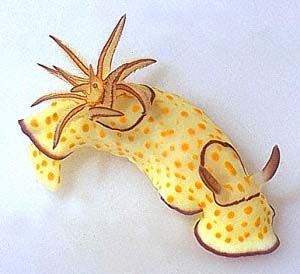
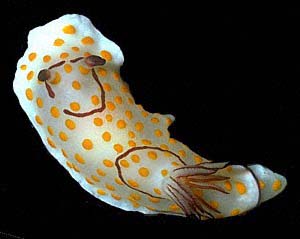
Chromodoris annulata
Eliot, 1904
Order: NUDIBRANCHIA
Suborder: DORIDINA
Family: Chromodorididae
DISTRIBUTION
Indian Ocean. One record from eastern Pacific.
PHOTO
UPPER: Sewer Pipe, North Head, entrance to harbour, Dar es Salaam, Tanzania, September 1974. (Grows to 100mm long). PHOTO: Bill Rudman.
LOWER: Phi Phi Is., Southern Thailand, 7-15m, November 1989. PHOTO: D.J.Brunckhorst
This brilliantly coloured chromodorid is relatively common in East Africa and occurs as far east as Thailand. There is a characteristic purple ring around the gills and the rhinophores.
Compare with the very similarly coloured Risbecia ghardaqana and Risbecia pulchella, which occur with it in the Red Sea, and Risbecia imperialis which is found in the western Pacific. [See message on this topic].
There is one record of this species from the Gulf of California (Bertsch & Kerstitch, 1984). Any further records of this species outside the Indian Ocean would be very welcome as its apparent absence from the western Pacific would suggest the eastern Pacific record may have been with human assistance.
References:
• Gohar, H. A. F., & I. A. Aboul-Ela. 1957a. The development of three chromodorids (with the description of a new species). Publications of the Marine Biological Station, Al-Ghardaqa, Egypt, 9: 203-228, pls. 1-5.
• Rudman, W.B. (1973). Chromodorid opisthobranch Mollusca from the Indo-West Pacific. Zoological Journal of the Linnean Society, 52(3): 175-199.
• Rudman, W.B. (1987). The Chromodorididae (Opisthobranchia: Mollusca) of the Indo-West Pacific: Chromodoris epicuria, C. aureopurpurea, C. annulata, C. coi and Risbecia tryoni colour groups. Zoological Journal of the Linnean Society, 90: 305-407.
Rudman, W.B., 1999 (April 11) Chromodoris annulata Eliot, 1904. [In] Sea Slug Forum. Australian Museum, Sydney. Available from http://www.seaslugforum.net/find/chroannu
Related messages
Re: Chromodoris annulata colour form from the Persian Gulf
May 4, 2010
From: Lawrence Neal
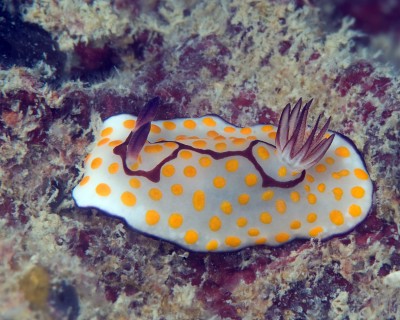
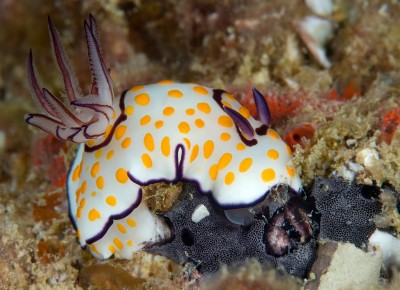
Concerning message #23600:
Dear Bill,
Referring to your reply to message #23600 ... here is a photo of the variant of Chromodoris annulata with a line joining the two purple rings from the Andaman Sea (very sorry to disprove the longstanding belief that this 'spectacled' form was restricted to the Persian Gulf). However, like the 'spotless' form also present in the Andaman Sea [see message #9203], this variant is much less common than the 'standard' form.
I also attached a shot of the 'standard' form feeding on the purple-black sponge, which confirms previous observations.
Locality: Condreco Wreck, Thai Muang, 15 metres, Phangnga, Thailand, Andaman Sea, Sponge-encrusted shipwreck. Photo 1: 22 April 2010, Length: 30 mm. Photo 2: 14 November 2009, Length = 50 mm. Photographer: Lawrence Neal.
Best regards,
Lawrence
lorenzo_n@yahoo.com
Neal, L., 2010 (May 4) Re: Chromodoris annulata colour form from the Persian Gulf. [Message in] Sea Slug Forum. Australian Museum, Sydney. Available from http://www.seaslugforum.net/find/23605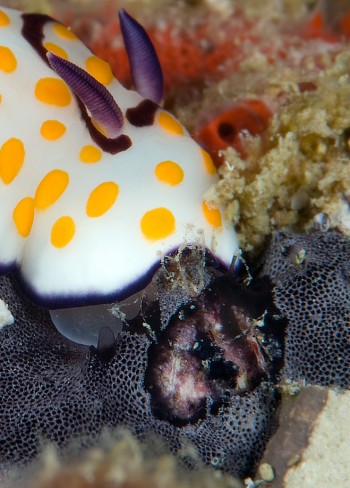
Dear Lawrence,
Thanks for exploding the idea that the Persian Gulf was harbouring a strange colour form. It didn't really make biological sense. I had also forgotten Danny Van Belle's message [#9135] showing an animal from Thailand with nearly complete 'spectacles'.
Thanks also for another record of C. annulata feeding on Chelonaplysilla violacea - there is no doubt about the identity of the sponge - and the bite marks -, in your photo. I suspect the 'spectacled' animal is also sitting on a colony of this sponge as well, but despite enlarging your photo, I can see no sign of sponge fibres so I can't be sure.
Best wishes,
Bill Rudman
Chromodoris annulata colour form from Persian Gulf
May 3, 2010
From: Mahdi Moradi Och Tapeh
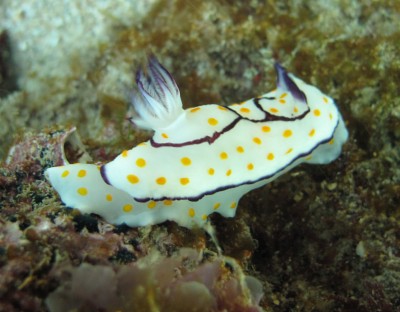
In duration my researches on Coral Reef in Persian Gulf I found this species on coral Reef bed in Larak & Qeshm Island, and I need to your guidance about identification and biology information of this species?
Locality: Larak Island- Bandar Abbas , 3-7 m , Iran, Persian Gulf , 5 January 2009, Coral Reef bed. Length: 2-3 cm. Photographer: Omid Alizade .
Best Regard
Mahdi Moradi
biologymoradi@gmail.com
Moradi, M., 2010 (May 3) Chromodoris annulata colour form from Persian Gulf. [Message in] Sea Slug Forum. Australian Museum, Sydney. Available from http://www.seaslugforum.net/find/23600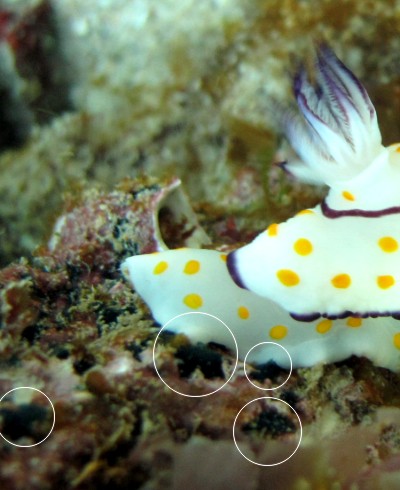
Dear Mahdi,
This is Chromodoris annulata, as in your separate message [#23597]. I am glad you sent it as well because it shows an interesting colour form, which is only known from the Persian Gulf, in which the two purple rings are linked together with a purple line.
Interstingly, this animal has also been found in an area where dark purple-brown patches or lumps are present. As I commented in your earlier message, I am pretty sure these lumps are part of a large colony of the sponge Chelonaplysilla violacea on which C. annulata feeds.
Best wishes,
Bill Rudman
Chromodoris annulata from Larak Island, Iran
May 3, 2010
From: Mahdi Moradi Och Tapeh
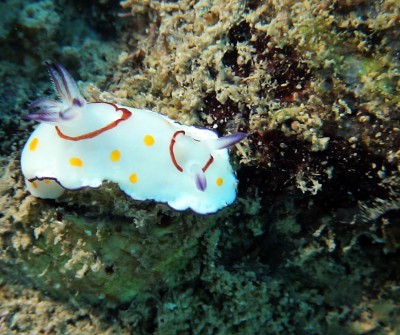
During my researches on Coral Reefs in the Persian Gulf I did find these species on coral Reef bed in Larak & Qeshm Island, and I need your guidance about identification and biology information of this species?
Locality: Larak Island - Bandar Abbas , 2-4 m , Iran , Persian Gulf , 27 July 2008, N 26 49' 35.2", E 56 19' 20.2", Coral Reef Bed. Length: 2.5 cm. Photographer: Mohammad Sharif Ranjbar .
Best Regard
Mahdi Moradi
biologymoradi@gmail.com
Moradi, M., 2010 (May 3) Chromodoris annulata from Larak Island, Iran. [Message in] Sea Slug Forum. Australian Museum, Sydney. Available from http://www.seaslugforum.net/find/23597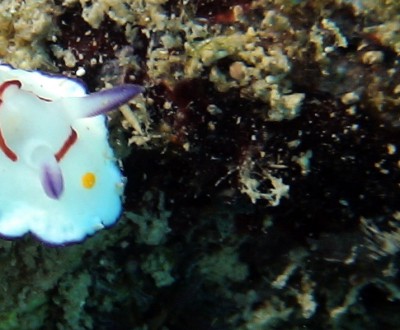
Dear Mahdi,
Welcome to the Sea Slug Forum. Although we have had observations from the Persian Gulf before, I don't recall any from Iran itself. I look forward to many more messages.
This is Chromodoris annulata which seems to be found along the east African coast and right along the northern shores of the Indian Ocean from the Red Sea to Thailand. I am pretty sure the dark reddish-purple patch in your photo is a colony of the sponge Chelonaplysilla violacea on which this chromodorid feeds.
Best wishes,
Bill Rudman
Re: Chromodoris annulata from Mediterranean coast of Israel
May 3, 2010
From: Louis Tisakkiros
Concerning message #22678:
I have photographed this nudibranch in Larnaca/Cyprus in late April 2009. You can add this to your sightings records
Locality: Dhekelia, 6 metres, Larnaca, Cyprus, Mediterranean, 21 April 2009, Rocky outcrop on a sandy bottom. Length: 50 mm . Photographer: Louis Tsiakkiros.
Louis Tsiakkiros
louis_tuw@hotmail.com
Tsiakkiros, L., 2010 (May 3) Re: Chromodoris annulata from Mediterranean coast of Israel. [Message in] Sea Slug Forum. Australian Museum, Sydney. Available from http://www.seaslugforum.net/find/23027Thanks Louis,
It would be nice to include a copy of your photo
Best wishes,
Bill Rudman
Chromodoris annulata from Mediterranean coast of Israel
October 5, 2009
From: Yoav Lavi
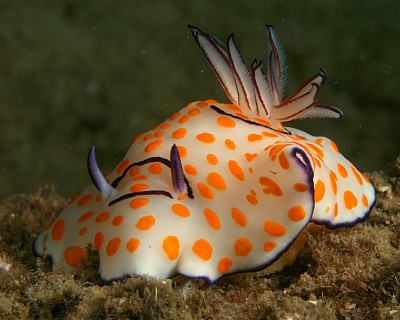
Hello,
The nudi in the attached picture was spotted on thursday 1 October 2009 near Caesarea, on the mediterranean coast of Israel.
Locality: Caesarea, 6 meters, israel, mediterranean, 01 October 2009. Length: 70 mm. Photographer: Yoav Lavi.
Yoav Lavi
dr.yoav.lavi@gmail.com
Lavi, Y., 2009 (Oct 5) Chromodoris annulata from Mediterranean coast of Israel. [Message in] Sea Slug Forum. Australian Museum, Sydney. Available from http://www.seaslugforum.net/find/22678Dear Yoav,
Thanks for this interesting record of Chromodoris annulata. Although not listed on the CIESM Atlas of Exotic Species in the Mediterranean Sea there are recent records of this species from both Greece and Turkey, which combined with your find from the mediterranean coast of Israel, suggests this is almost certainly a Lessepsian migrant to the Mediterranean from the Red Sea.
-
Daskos A. & Zenetos, A. (2007) Additions to the knowledge of alien Opisthobranchia of Greece. Aquatic Invasions 2(3): 258-260
-
Gokoglu, M. and Ozgur, E. (2008) First report of Chromodoris annulata Eliot, 1904 (Mollusca, Opisthobranchia, Chromodorididae) on the Levantine coast of Turkey, Eastern Mediterranean. Aquatic Invasions 3(4): 435-437
Best wishes,
Bill Rudman
Re: Chromodoris annulata from Gulf of Oman
September 22, 2008
From: William Messruther

Concerning message #21891:
Here are some additional shots of Chromodoris annulata which may help with the feeding matter (now I know what is the “head end” I will make sure I get it right next time – these were my first shots of nudis so please excuse my ignorance – can do better.
By the way Bill what is the blob at the rear of the animal? Shudder to ask but just wondered.
Cheers
William
willnita@eim.ae
Messruther, W.R., 2008 (Sep 22) Re: Chromodoris annulata from Gulf of Oman. [Message in] Sea Slug Forum. Australian Museum, Sydney. Available from http://www.seaslugforum.net/find/21896
Dear Will,
Thanks for the extra photos. It's a bit hard photographing something which is almost black right alongside something that is white and still retaining any detailed structure. However this photo certainly shows the same blackish sponge we saw in your earlier photo, and the slug certainly seems to be taking an interest in it. Although not 100% proof that it is eating this sponge, as I said in the earlier message, observations such as this help build up a picture for us, suggesting this is its food sponge.
Concerning the white blob at the rear of the animal. It is the posterior tip of the foot. If you imagine a garden snail, this 'blob' is equivalent to the bit of the foot behind the snail's shell. If you have a look at the species Fact Sheet you will see some other photos where this is a little clearer. Also have a look for other photos in the other messages on this species which are attached at the bottom of the Fact Sheet.
Best wishes,
Bill Rudman
Re: Chromodoris annulata from Red Sea & Persian Gulf
September 18, 2008
From: William Messruther
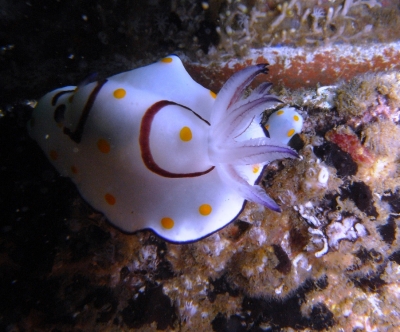
Concerning message #3267:
A photo of Chromodoris annulata.
Locality: Khor Fakan, 18 meters, UAE, Indian Ocean, 13th September 2008, Inchcape 2 Wreck. Length: 20 cm. Photographer: William R Messruther.
William R Messruther
willnita@eim.ae
Messruther, W.R., 2008 (Sep 18) Re: Chromodoris annulata from Red Sea & Persian Gulf. [Message in] Sea Slug Forum. Australian Museum, Sydney. Available from http://www.seaslugforum.net/find/21891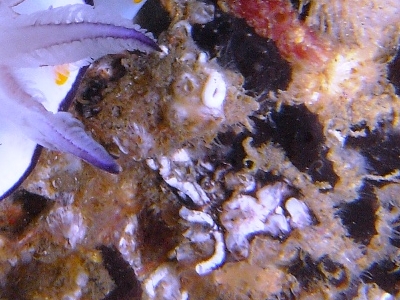
Dear Will,
Thanks for another interesting photo. I have included a close-up alongside which shows dark blue 'lumps' which are parts of a large, partly overgrown, sponge colony. I suspect the sponge is Chelonaplysilla violacea. I have been trying to get some good observations showing what Chromodoris annulata feeds on, and in an earlier message [#21749] we had it feeding on this sponge. Although we can't actually see the head end in your photo, I wouldn't be surprised if your C. annulata was feeding on this colony. Although not direct evidence, the accumulation of similar photos showing an association between this sponge and this chromodorid, is a useful indication.
Best wishes,
Bill Rudman
Spotless Chromodoris annulata from Thailand
November 27, 2007
From: Hans van Rijn
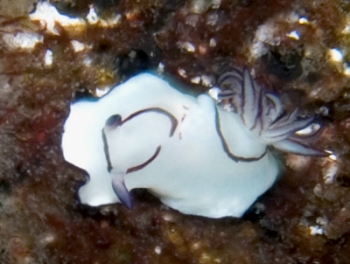
Although it lacks the yellow spots could this be Chromodoris annulata?
Locality: Koh Ha Yai island, 4 m, Thailand, Andaman Sea, 18 March 2007, rocky bay in offshore island. Length: 20mm. Photographer: Hans van Rijn.
Hans van Rijn
hvrijn@orange.nl
Rijn, Hans van, 2007 (Nov 27) Spotless Chromodoris annulata from Thailand. [Message in] Sea Slug Forum. Australian Museum, Sydney. Available from http://www.seaslugforum.net/find/21198Dear Hans,
I am sure this is a spotless form of C. annulata. We have a couple of earlier records of this colour form from Thailand [#9463, #9203] so its nice to get another confirmation.
Best wishes,
Bill Rudman
Chromodoris annulata from the Red Sea
October 4, 2007
From: Kamal El Tawil
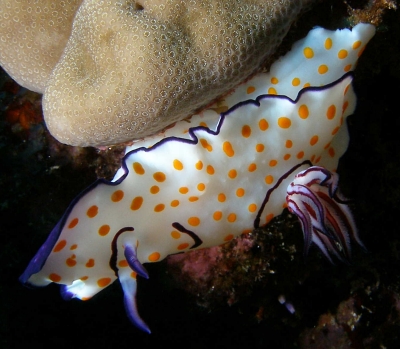
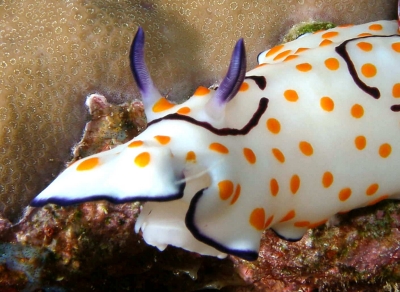
Dear Bill,
This Chromodoris annulata was crawling along the reef wall. It "twisted and distorted" ( in reference to your reply to my message # 20787 ) its body to move from one part of the reef to another. Thanks to your comment, I find that such twists and distortions add value to the pictures and I hope also to the Forum.
Locality: Abington reef, , 10-12 metres, Sudan, Red Sea, 14 April 2007, Reef wall. Length: 40 mms. Photographer: Kamal El Tawil.
Kindest regards,
Kamal el Tawil
www.coralworld.net
kamal@coralworld.net
El Tawil, K., 2007 (Oct 4) Chromodoris annulata from the Red Sea. [Message in] Sea Slug Forum. Australian Museum, Sydney. Available from http://www.seaslugforum.net/find/20849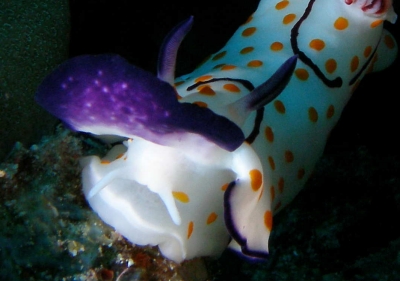
Dear Kamal,
Thanks for these photos. I agree with your comments about twists and distortions adding value - it allows you to see things in photos which you can only usually see in the living animal - in this case the damage to the front of the mantle and the bright purple on the underside of the anterior mantle.
In my earlier comment I was referring to a time when cameras needed expensive slide film and I had to limit the number of photos I could take - so if I had to decide between a good 'normal' shot -and a natural distorted shot, the normal shot usually one the day.
Best wishes,
Bill Rudman
Chromodoris annulata from the Egyptian Red Sea
August 4, 2007
From: Eddy Mannak
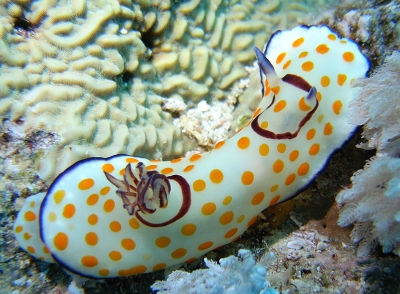
Hello Bill,
Here are photos of Chromodoris annulata for your Forum.
Locality: Hurghada, 20 metres, Egypt, Red Sea, 22 June 2007. Length: 90 mm. Photographer: Eddy Mannak.
Greetings,
Eddy Mannak
eddy.mannak@wanadoo.nl
Mannak, E., 2007 (Aug 4) Chromodoris annulata from the Egyptian Red Sea. [Message in] Sea Slug Forum. Australian Museum, Sydney. Available from http://www.seaslugforum.net/find/20346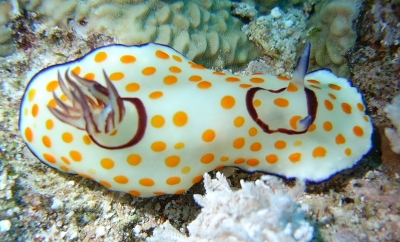
Dear Eddy,
It's nice to get photos of this species from the Egyptian Red Sea as Gohar & Aboul-Ela (1957) published some interesting work on this species and two very similarly coloured species from that part of the world. They described a new species, Risbecia ghardaqana which has remained a bit of a puzzle since then [see my message #9625]. If you have any photos of an animal similar to C. annulata but lacking the purple rings, it would be nice to see it.
• Gohar, H. A. F., & I. A. Aboul-Ela. 1957a. The development of three chromodorids (with the description of a new species). Publications of the Marine Biological Station, Al-Ghardaqa, Egypt, 9: 203-228, pls. 1-5.
Best wishes,
Bill Rudman
Re: Chromodoris annulata from Thailand
November 28, 2006
From: Asther Lau
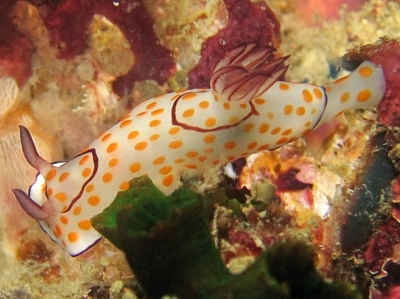
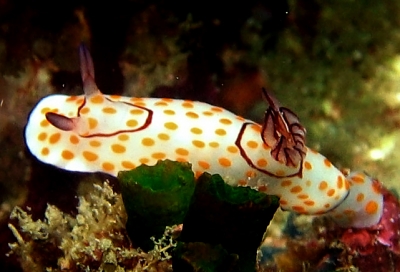
Concerning message #9121:
Dear Bill,
Came across this Chromodoris annulata during my dive at the Andaman Sea early this year. Took a few pics while it was "gliding" on the wall of big boulder.
Locality: Bida Nok Rock, Phi Phi Island, Approx. 16 metres, Phuket, Thailand, Andaman Sea, 4th Jan 2006, Wall covered with softcorals & silt.. Length: About 4cm. Photographer: Asther M. Lau.
Regards,
Asther
asther@astherlau.com
Lau, A, 2006 (Nov 28) Re: Chromodoris annulata from Thailand. [Message in] Sea Slug Forum. Australian Museum, Sydney. Available from http://www.seaslugforum.net/find/18543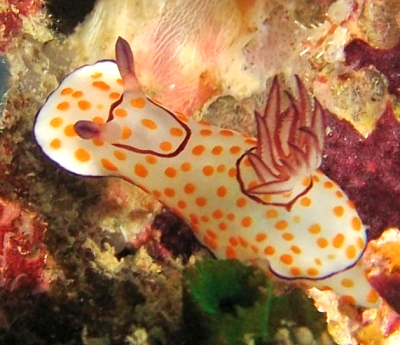
Dear Asther,
As I've commented before, it is very interesting to get records of C. annulata from Thailand. Apart from one puzzling, (and not repeated) record of this species from the Gulf of California (Kerstitch, 1989), it was only known before from the western Indian Ocean.
-
Kerstitch, A. (1989) Sea of Cortez marine Invertebrates. A guide for the Pacific Coast, Mexico to Ecuador. Monterey, California, Sea Challengers. 113 pp.
Best wishes,
Bill Rudman
Damaged? Chromodoris annulata
June 21, 2006
From: Kamal El Tawil
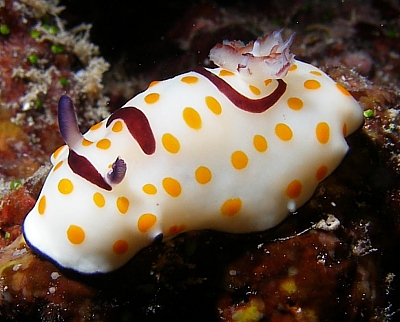
Hi Bill:
The gills and rhinophores of this Chromodoris annulata are not normal. Can you comment ? Picture was taken on a night dive.
Locality: Dangerous reef, St. John's Reef - Egyptian Red Sea, 8 metres, Egypt, Red Sea, 10 June 2006. Length: 4 cms. Photographer: Kamal el Tawil.
Regards,
Kamal
www.coralworld.net
kamal@coralworld.net
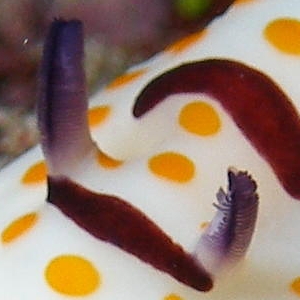
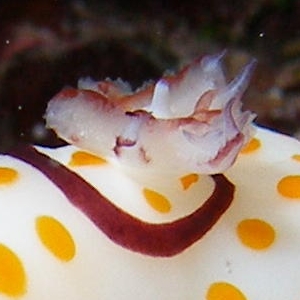
Dear Kamal,
From the look of the gills and rhinophores I would say that they have been damaged. I don't think it's a result of developmental abnormality. My guess is that they have been bitten by some inquisitive fish. Species of Chromodoris have mantle glands around the mantle edge which contain distasteful chemicals, acquired from their food sponges, which give them considerable protection for predation [see #15481]. Some species also contain small packets of these chemicals in their gills and rhinophores, which can be seen as small opaque white spots. However these defences aren't perfect, and fish have to have a taste before they learn to avoid chromodorids. Since the animal is still alive I guess the taste test worked. Most nudibranchs can repair this sort of damage quite quickly.
Best wishes,
Bill Rudman
Chromodoris annulata ? from Bahrain
December 16, 2005
From: Michael Arora
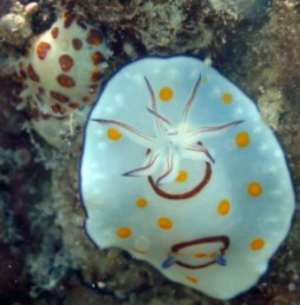
Hi all
Great website very useful. I've come across these beasts many times in Bahrain (Persian Gulf) typically amongst dead coral structrues.
Locality: Bahrain, Persian Gulf, dead coral reef. Depth: 2 m - 5 m, Length: 40 mm. October 2005. Shallow. Photographer: Mike Arora
I would be grateful if somebody could identify them (see photos attached for three? different species). On the lower photo please note the link between the two rings.
Thanks
Mike
michael@phegulf.com.bh
Arora, M.K, 2005 (Dec 16) Chromodoris annulata ? from Bahrain. [Message in] Sea Slug Forum. Australian Museum, Sydney. Available from http://www.seaslugforum.net/find/15481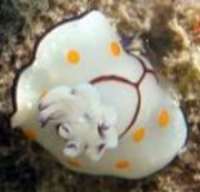
Dear Mike,
The yellow spotted animals are both Chromodoris annulata. It is very interesting to see another specimen with the purple link between the two purple rings. The only region this colour form has been reported from is the Persian Gulf. If you look through the attached messages for this species you will see other examples of this peculiar form. It is certainly interesting that it has such a restricted geographic range.
I really am not sure about the black spotted animal in the upper photo. It looks a bit like Phyllidia scottjohnsoni but I can't see enough in the photo. If it is that species it would be interesting because that is only known from the western Pacific at present.
Best wishes,
Bill Rudman
Juvenile Chromodoris annulata ?
October 20, 2005
From: Oren Lederman
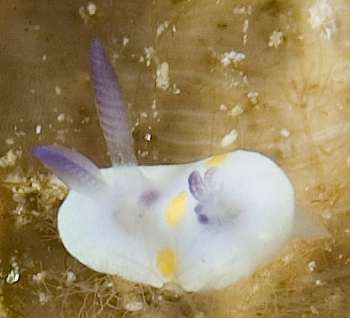
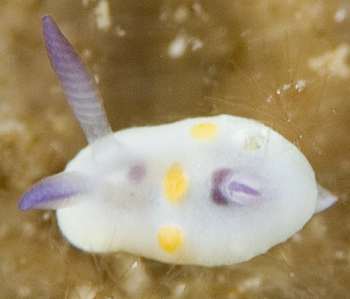
Hi Bill,
Do you think this is a juvenile Chromodoris annulata?
Locality: Near the "Yetush" shipwreck, Eilat Bay, Israel. Red Sea. Depth: 25 meters. Length: ~0.5 cm. 09 October 2005. Coral head. Photographer: Oren Lederman
Oren Lederman
lederman@bigmail.co.il
Lederman, O., 2005 (Oct 20) Juvenile Chromodoris annulata ?. [Message in] Sea Slug Forum. Australian Museum, Sydney. Available from http://www.seaslugforum.net/find/15058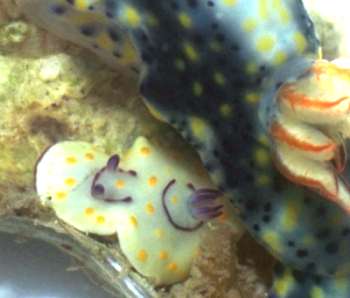
Dear Oren,
It could well be, but there are Risbecia pulchella, R. ghardaqana which we shouldn't forget. Your photos are a good example of the different proportions we find in juveniles, with relatively very large rhinophores. It's one way we can make an intelligent guess as to whether a small chromodorid is a small adult or a small juvenile of a larger species.
Your photos reminded me of a relatively small C. annulata I found in Dar es Salaam. It was about 12 mm long and had most of its colour pattern, and its rhinophores had assumed their adult proportions. I have posted a photo here alongside my comments.
Photo: Entrance to harbour, Dar es Salaam, Tanzania, July 1974. Approx 12 mm long alive. With adult Hypselodoris infucata. Photo: Bill Rudman.
Best wishes,
Bill Rudman
Re: Chromodoris annulata - colour markings
January 27, 2005
From: Iain Macdonald
I believe you could use the reference for the appearance of the local (Persian Gulf) colour variation of Chromodoris annulata as it appears on the front cover of this report.
-
Krupp, F., Abuzinada, A.H., Nader, I.A. (editors) 1996. A Marine Wildlife Sanctuary for the Arabian Gulf: Environmental Research and Conservation Following the 1991 Gulf War Oil Spill. Senckenbergische Naturforschende Gesellschaft, Frankfurt, Germany. ISBN 3-929907-37-2.
Iain Macdonald
dr_iamacdonald@yahoo.co.uk
Macdonald, I.A., 2005 (Jan 27) Re: Chromodoris annulata - colour markings. [Message in] Sea Slug Forum. Australian Museum, Sydney. Available from http://www.seaslugforum.net/find/13018Thanks Iain,
Bill Rudman
Chromodoris annulata from the Egyptian Red Sea
January 3, 2005
From: Michael Mrutzel
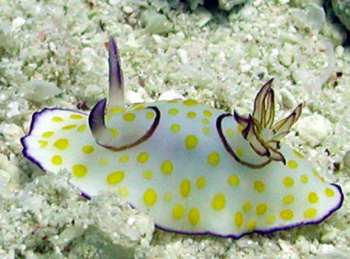
Hello Bill
Here is a photo of Chromodoris annulata for your Forum
Locality: Reef at Hurghada, Egypt, Red Sea. Depth: 30 meters. Length: 50 mm. June 2004. Photographer: M.Mrutzek
Michael Mrutzel
Michael@meeresaquaristik.de
Mrutzel, M., 2005 (Jan 3) Chromodoris annulata from the Egyptian Red Sea. [Message in] Sea Slug Forum. Australian Museum, Sydney. Available from http://www.seaslugforum.net/find/12876Thanks Michael,
Its good to get photos of some of these 'common' western Indian Ocean species. It gives us a better idea of colour variation in the species.
Best wishes,
Bill Rudman
Re: Chromodoris annulata - colour markings
December 31, 2004
From: Iain Andrew Macdonald
Dear Bill,
Concerning your question: Yes they occur on the same wreck site and I have photos of both from this site, next time i will try and get a shoot of both types in one frame.
Best regards,
Iain Macd.
Dr_iamacdonald@yahoo.co.uk
Macdonald, I.A., 2004 (Dec 31) Re: Chromodoris annulata - colour markings. [Message in] Sea Slug Forum. Australian Museum, Sydney. Available from http://www.seaslugforum.net/find/12865Thanks Iain,
It would be nice to have a photo of the two together. If you get a chance to photograph them feeding on aparticular sponge, or laying eggs, that would be valuable as well
Bill Rudman
Chromodoris annulata - colour markings
December 30, 2004
From: Dr. Iain Andrew Macdonald
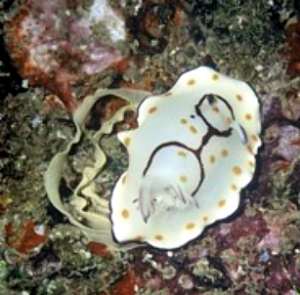
For your information, I have observed this colour pattern of Chromodoris annulata in the coastal waters of Qatar. The two purple circles are joined by a purple line. I haven't seen it in the literature I have. I thought it would make a nice addition to your web site.
Locality: MO Wreck, East of Doha, 20 m, Qatar, Persian Gulf, Indian Ocean. Length: 50-70 mm. June 2004, on wreck. Photographer: Iain Macdonald
Dr. Iain Andrew Macdonald
Dr_iamacdonald@yahoo.co.uk
Macdonald, I.A., 2004 (Dec 30) Chromodoris annulata - colour markings. [Message in] Sea Slug Forum. Australian Museum, Sydney. Available from http://www.seaslugforum.net/find/12822Dear Iain,
Thanks for this information. This colour form is not recorded anywhere in the printed literature but we have a number of records on the Sea Slug Forum of this peculiar colour form of C. annulata, and all of them are from the Persian Gulf [= Arabian Gulf] and the Gulf of Oman at the NW corner of the Arabian Sea. [see messages #4339, #7162, #3586, #3267 ].
It is good to get another record. I would be interested to know if the typical colour form, without the line connecting the circles, is found in the same region?
Best wishes,
Bill Rudman
Chromodoris annulata - population, natural history
June 2, 2003
From: Kathrin Lüttmann
Hi Bill,
First of all: thank's for this web site! I have found a lot of infos I needed!!!!
I'm a German biology student and I just arrived back from a field trip to Egypt with a marine biology course.
I have been working on a project with Chromodoris annulata. Our location, or rather our observing area, was an intertidal zone sourrounded by a few mangroves in Mangrove Bay, Sinai, Egypt.
So my question now is: Is there any information on population size on slugs at all or especially on C. annulata? Are they more active during the night or during the day? - How come we found most of them in an intertidal zone, but still you find them in depths up to 20m? - What we found at Mangrove Bay was, that they seem to hide during high tide and come out at low tide. Do you think they prefer hot water temperatures? We even found one slug totally out of the water!
I would be very happy if you would find some time and some ideas to answer my questions. Thank you,
Kathrin
Kathrin.luettmann@gmx.de
Dear Kathrin,
The only study I know of on C. annulata is Gohar & Aboul-Ela's (1957) which gives some background information and compares the species with two other yellow-spotted species. [See message about this paper]. There has been quite a lot of work done on nudibranch populations, but much of it has been on temperate species. Have a look at Thompson & Brown, (1984) for a good source of references on the topic - though there are many more to add to their bibliography. Two very relevant papers are those by Scott Johnson I list below on tropical distributions.
• Gohar, H. A. F., & I. A. Aboul-Ela. 1957a. The development of three chromodorids (with the description of a new species). Publications of the Marine Biological Station, Al-Ghardaqa, Egypt, 9: 203-228, pls. 1-5.
• Johnson, S. (1983) Distribution of two nudibranch species on a subtidal reef on the western shore of Oahu, Hawaii. The Veliger, 25(4): 356-364.
• Johnson, S. (1989) Temporal patterns of nudibranch mollusk activity on a subtidal Hawaiian reef. The Veliger, 32(1): 1-7.
Hope this is will be of some use,
Bill Rudman
Chromodoris annulata from the Red Sea
May 9, 2003
From: Ilan Ben Tov
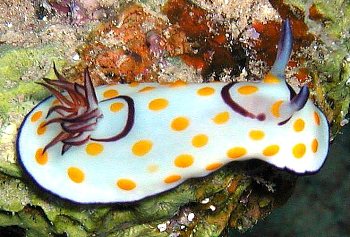
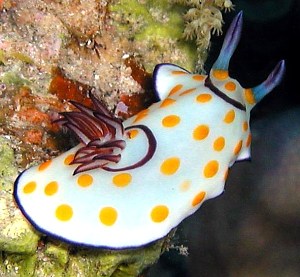
Hi Bill
I took this picture of Chromodoris annulata in Ras Ghoslani, Sinai at the Red Sea. It was taken at April 20 in depth of 15 meters.
Ilan.
ilanbt@gilat.com
Tov, I.B., 2003 (May 9) Chromodoris annulata from the Red Sea. [Message in] Sea Slug Forum. Australian Museum, Sydney. Available from http://www.seaslugforum.net/find/9773Thanks Ilan,
At least when it has its purple rings we can be sure this is C. annulata,, and not one of the other yellow-spotted species.
Best wishes,
Bill Rudman
Chromodoris annulata from Burma (Myanmar)
April 1, 2003
From: Orhan Aytur
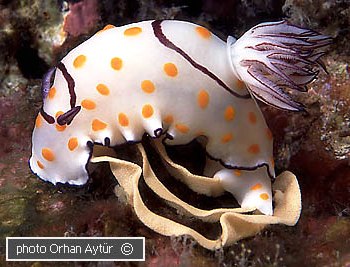
Hi Bill,
Here is a picture of a Chromodoris annulata laying eggs.
Mergui Islands, Burma (Myanmar), Depth: 4-6m, January 2003. Dive site: Black Rock
Cheers,
Orhan
aytur@ee.bilkent.edu.tr
Aytur, O., 2003 (Apr 1) Chromodoris annulata from Burma (Myanmar). [Message in] Sea Slug Forum. Australian Museum, Sydney. Available from http://www.seaslugforum.net/find/9489Dear Orhan
Thanks for another photo of the egg-ribbon. It's always good to get a few photos to see whether there is any variation in the shape and colour.
Best wishes,
Bill Rudman
What does Chromodoris annulata eat?
March 28, 2003
From: Gabriella Titone
Could, please, anybody answer my two questions about the beautiful species Chromodoris annulata?
• what does it eat?
• which is the lower temperature that it can bear?
I saw it in the Red Sea
Thank you!!
Gabriella
Frogghino@yahoo.it
Dear Gabriella,
It will certainly be a sponge feeder, and will at most only eat one or two particular species. Unfortunately, like most chromodorid species, we don't know which species it feeds on. We have a photo of one in Abu Dhabi from Pete Hardy, showing one on a pinkish sponge, but there is no guarantee it wasn't just crawling over it. Concerning the lowest temperature it can bear - I would have no idea. It is a tropical species but I doubt if anyone has ever studied its heat tolerance. Your questions give me the feeling that you may be wondering about keeping one in your aquarium. Have a look at the 'Keeping in captivity' page and the Hypselodoris bullocki Pages for my views on the topic.
Best wishes,
Bill Rudman.
Chromodoris annulata & egg ribbon from Burma
March 27, 2003
From: Mary Jane Adams
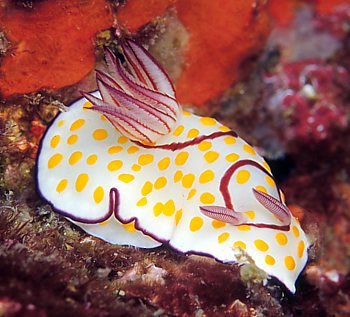
Hi Bill,
Chromodoris annulata is fairly common in the Mergui Archipelago, Andaman Sea, Myanmar. One of the dive guides told me that most of them have yellow spots and two separate rings, but every few months they see a spotless one or one with a purple line connecting the rings.
On Feb. 14, 2003, I saw this one (Upper Right) laying eggs at 5 meters on a vertical wall at Three Islets. Unfortunately, I was out of film.
When I went back to photograph it on my next dive, the slug had finished the egg ribbon (Lower Right) and was crawling around near by so I photographed them separately. The depth was 5 meters.
The Lower Left Image shows that the underside of the anterior mantle is deep purple. Perhaps this indicates some kinship with Chromodoris hintuanensis and C. geometrica?
Best regards,
Mary Jane
divepng@yahoo.com
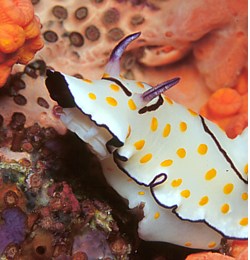
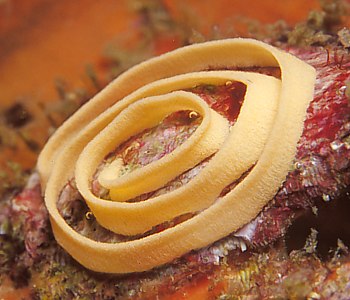
Dear Mary Jane,
Thanks for both for the egg mass photo and the photo of the purple mantle underside. I thought I had listed somewhere all the species with a purple underside to the anterior mantle. It occurs in a group of species with a very broad mantle overlap. Perhaps they do represent an inter-related group of species within the genus. I can think offhand of the following species with this purple underside to the anterior mantle. If anyone can think of any more it would be nice to have a complete list.
Chromodoris annulata
Chromodoris coi
Chromodoris conchyliolata
Chromodoris geometrica
Chromodoris gleniei
Chromodoris hintuanensis
Chromodoris leopardus
Best wishes,
Bill Rudman
Spotless Chromodoris annulata from Myanmar
March 27, 2003
From: Mary Jane Adams
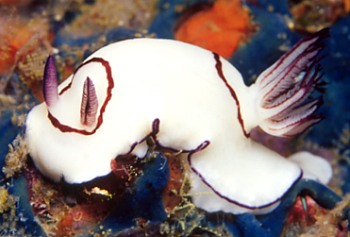
Hi Bill,
Thanks to sharp-eyed dive guide, Hans Tibboel, I was able to photograph a spotless Chromodoris annulata at Western Rocky, Mergui Archipelago, Andaman Sea, Myanmar on Feb. 25, 2003. It was clinging to a vertical wall at about 7 meters in heavy surge. It was about the same size as the "normal" C. annulata in the area--about 3cm long.
Hans told me he only sees the spotless variety about once every couple of months.
Best regards,
Mary Jane
divepng@yahoo.com
Adams, M.J., 2003 (Mar 27) Spotless Chromodoris annulata from Myanmar. [Message in] Sea Slug Forum. Australian Museum, Sydney. Available from http://www.seaslugforum.net/find/9463Thanks Mary Jane,
This is a nice complement to Danny Van Belle's photos of similar 'spotless' animals from Thailand.
Bill Rudman
Re: Magnificent spotless Chromodoris annulata
February 24, 2003
From: Hans Tibboel
Dear Sir,
On dives in the Mergui Archipelago (Myanmar) we regularly encounter this particular colour form of Chromodoris annulata as well. At one particular site, Black Rock, they seem to be quite "common" and we've seen them mating with other Chromodoris annulata that have the orange spots!
Hans Tibboel
hans@fantasea.net
Dear Hans,
Thanks for this interesting information. If you are able to send photos, especially of spotted and unspotted forms mating, they would be very welcome.
Best wishes,
Bill Rudman
Magnificent spotless Chromodoris annulata
February 14, 2003
From: Danny Van Belle
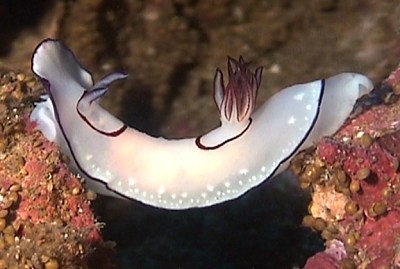
Hi Bill,
As promised in my earlier message ....... More Chromodoris annulata but this one is stunningly beautiful! Marvellous video footage!
Depth: 30m
Divesite: KoH Ha - South Thailand - Andaman Sea, 07 February 2002.
I should measure them more often but this one was not small. As I've seen this one only once I attach many pictures! I hope they're useful!
Best wishes and thanks a lot for all the info I could find on the Sea Slug Forum.
Danny Van Belle
dannyvb@hotmail.com
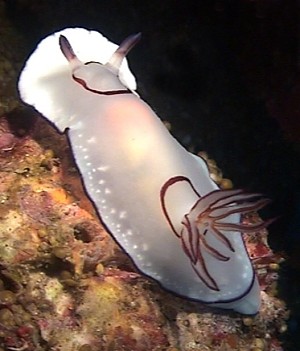
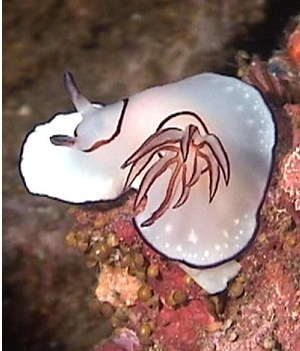
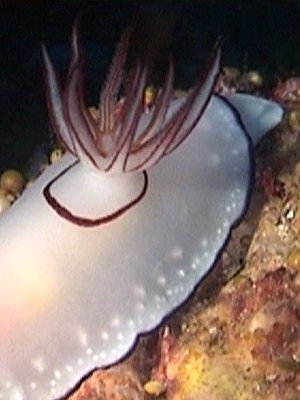
Dear Danny,
I can see why your are so excited about this find. It is indeed beautiful, and I agree it definitely appears to be a specimen of Chromdoris annulata without its yellow spots. The purple border, purple rings, and the gills, triangular in cross section are all characteristic of this species. Yesterday I was saying that your yellow spotted C. hintuanensis might be a suggestion that Thailand was a centre of yellow-spotted species and today you show me a yellow-spotted species without its spots! It's certainly a very interesting variation.
Best wishes,
Bill Rudman
Special Chromodoris annulata
February 11, 2003
From: Danny Van Belle
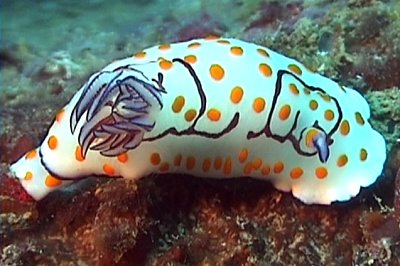
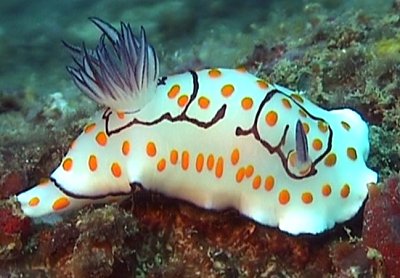
Hi Bill,
Here is Chromodoris annulata with a missing rhinophore -but it's possible it never had two?!
Divesite: Boonsung Wreck, off the west coast of Thailand near Tap Lamu, Andaman Sea
Date: 3 March 2001
Depth: 13m
By the way I've got some footage of Chromodoris annulata (albino?) missing the orange spots on it's body! Pictures very soon!
Cheers
Danny Van Belle
dannyvb@hotmail.com
Van Belle, D., 2003 (Feb 11) Special Chromodoris annulata. [Message in] Sea Slug Forum. Australian Museum, Sydney. Available from http://www.seaslugforum.net/find/9135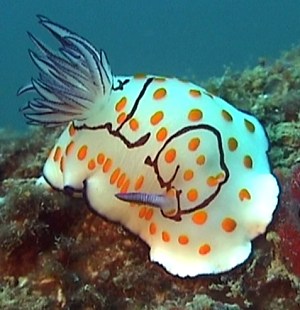
Dear Danny,
What with your earlier photos and your promised 'spotless' ones, we are getting a good picture of colour variation of this species at the eastern edge of its range. In this animal, both the anterior and posterior purple rings are irregular. Concerning the left rhinophore - as you say, it is possible it has never had one.
best wishes,
Bill Rudman
Chromodoris annulata from Thailand
February 6, 2003
From: Danny Van Belle
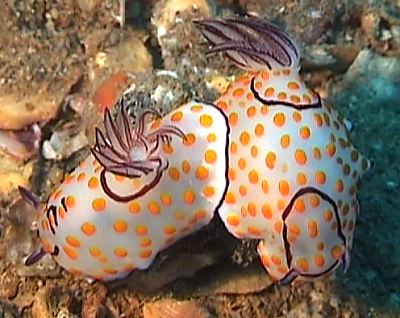
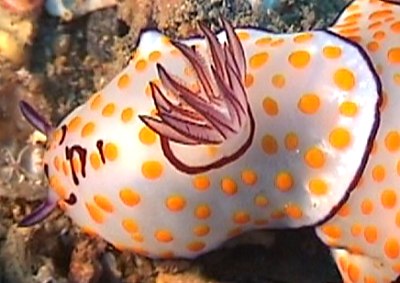
Hi Bill,
I hear it's very hot over there. Here in Europe we get covered up in snow! Here are some nice videopictures of 2 Chromodoris annulata together! These videopictures were taken at the Boon Sung wreck, an old tin mining boat, off the west coast of Thailand near Tap Lamu, Andaman Sea.
Danny
dannyvb@hotmail.com
Van Belle, D., 2003 (Feb 6) Chromodoris annulata from Thailand. [Message in] Sea Slug Forum. Australian Museum, Sydney. Available from http://www.seaslugforum.net/find/9121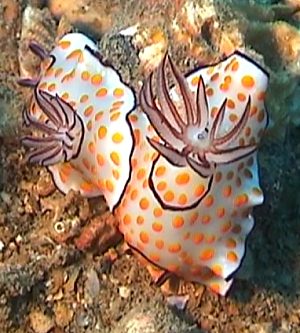
Thanks Danny,
Its good to get a collection of photos of some of these animals from the extremes of their geographic range, just to see how they are varying and how they are fitting in with similarly coloured species. The anterior purple ring around the rhinophores is starting to look a bit optional in Thailand.
Concerning the weather - There is a town in western New South Wales which is now in its fourth week of temperatures over 45 deg C. They haven't seen rain for 2 years, let alone snow!
Best wishes,
Bill Rudman
Chromodoris annulata from Abu Dhabi
July 17, 2002
From: Peter Hardy
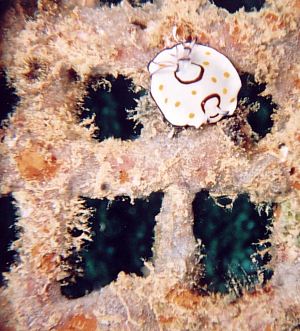
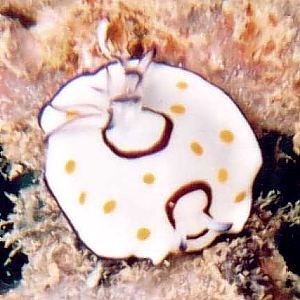
Bill,
In answer to your question I have included another couple of photos taken on the same day. [Abu Dhabi, United Arab Emirates, 25 meters, 3 May 2001].
Pete
hardy@emirates.net.ae
Hardy, P. , 2002 (Jul 17) Chromodoris annulata from Abu Dhabi. [Message in] Sea Slug Forum. Australian Museum, Sydney. Available from http://www.seaslugforum.net/find/5989Thanks Pete,
Its interesting to know that at least in some places, the form of Chromodoris annulata with the rings connected by a median line, coexists with the form without the line. It is possible that pinkish-grey sponge it is on is its food sponge - it would be nice to have some further photos of it on this type of sponge.
Bill Rudman
Re: Chromodoris annulata from United Arab Emirates
June 7, 2002
From: Melinda Barry
Dear Dr Rudman,
Thank you very much for identifying our sea slug! Fujeirah, where we found it, is on the East coast of the United Arab Emirates, and therefore to be precise it was in the Indian Ocean rather than the Persian Gulf.
We actually live in Dubai, on the west coast, but occasionally go to the East coast as the diving and snorkelling are better there. This is the only time we have ever seen a sea slug in either location, but we will keep a sharper eye out for them in future and will let you know if we find any more.
Melinda Barry
barrycm@emirates.net.ae
Barry, M., 2002 (Jun 7) Re: Chromodoris annulata from United Arab Emirates. [Message in] Sea Slug Forum. Australian Museum, Sydney. Available from http://www.seaslugforum.net/find/7183Dear Melinda,
I look forward to your future finds
Best wishes,
Bill Rudman
Chromodoris annulata from United Arab Emirates
June 6, 2002
From: Melinda Barry
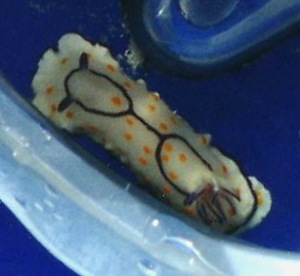
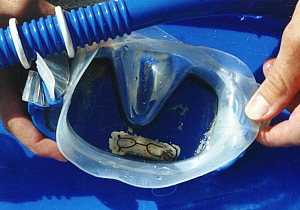
We found this nudibranch in quite shallow water (just snorkelling), rocky, off the coast of Fujeirah, United Arab Emirates, in Feb 2001.
I haven't seen it on any of the nudibranch websites I have checked so far and would like to know what type it is.
Melinda Barry
barrycm@emirates.net.ae
Barry, M., 2002 (Jun 6) Chromodoris annulata from United Arab Emirates. [Message in] Sea Slug Forum. Australian Museum, Sydney. Available from http://www.seaslugforum.net/find/7162Dear Melinda,
This is a colour form of Chromodoris annulata apparently found only in a small part of the northern Indian Ocean. If you look at other messages and photos on this page you will see that in most of the Indian Ocean C. annulata has two purple rings on its back. However if you look at the other messages on this page you will see that specimens from the Persian Gulf also have a single median line connecting the two rings to each other.
It is certainly an interesting geographic variation. It would be interesting to know if the form without the connecting line is also found there as well.
Best wishes,
Bill Rudman
Chromodoris annulata from the Red Sea
April 18, 2002
From: Marina Poddubetskaia
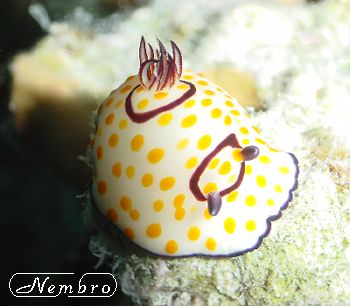
Dear Bill,
Here is another nudibranch I photographed at the end of March in Egypt. It was a dive cruise at the North of Red Sea, between Hurghada and Sinai mountains. All the joined photos come from there. Could you confirm that it is Chromodoris annulata.
Data: about 5cm, 20 March, 2002, "Chebna" div site, North Red Sea, 5m depth, sunset dive.
Best wishes,
Marina.
marina.poddubetskaia@francetelecom.com
Poddubetskaia, Marina. , 2002 (Apr 18) Chromodoris annulata from the Red Sea. [Message in] Sea Slug Forum. Australian Museum, Sydney. Available from http://www.seaslugforum.net/find/6727Dear Marina,
Yes this is C. annulata. It is a very distinctive species with yellow spots and purple rings. It was not uncommon in Tanzania, when I lived there, and seems to be one of the common species in the western Indian Ocean. Curiously, east of the Red Sea, in the Persian Gulf there seems to region where this species develops a purple line joining the two purple rings.
Best wishes,
Bill Rudman
Chromodoris annulata from Abu Dhabi
May 15, 2001
From: Peter Hardy
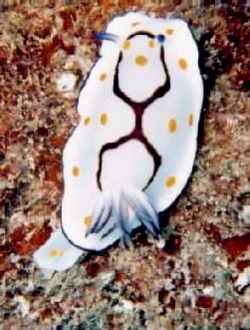
Dear Bill,
To accompany my photos of Chelidonura livida from Abu Dhabi, United Arab Emirates, I have also included a photo of the Nudi we usually see on our wrecks. This one was taken at 25 meters yesterday [3 May 2001].
Cheers
Pete
hardy@emirates.net.ae
Hardy, P., 2001 (May 15) Chromodoris annulata from Abu Dhabi. [Message in] Sea Slug Forum. Australian Museum, Sydney. Available from http://www.seaslugforum.net/find/4339Dear Pete,
This is Chromodoris annulata, which is quite common in both the western and northern Indian Ocean. usually the purple rings are separate so it is interesting to see your photo which matches Gordon Smith's photo from the Persian Gulf.
Do all the animals you see have this line joining the two purple rings or is there some variation?
Best wishes,
Bill Rudman
Chromodoris annulata - colour variation
January 25, 2001
From: Gordon T. Smith
Dear Bill,
I have been reviewing a lot of my slides recently for scanning purposes and following yesterday's dives at Khorfakkan [Gulf of Oman] I can definitely conclude that if there is a line joining the rings there are fewer yellow spots. [See Gordon's earlier message]. I found seven creatures yesterday (3 with lines) in slightly different locations, in fact first time I have found both types in the same area.
Although I hate to interfere with nature, what would be the chances of a pair mating if put together (i.e. one with the joining line and one without), would this prove that they are both of the same species?
Best regards
Gordon
aquashot@emirates.net.ae
Smith, G.T., 2001 (Jan 25) Chromodoris annulata - colour variation. [Message in] Sea Slug Forum. Australian Museum, Sydney. Available from http://www.seaslugforum.net/find/3586Dear Gordon,
If they are living in the same area then I don't think you would be interfering with nature by putting the different colour forms together. In fact you would be "letting nature take its course". Like most areas of science there are debates going on in biology over just what is a species. Keeping it simple, I would certainly consider two animals I found mating to be of the same species. It is also most unlikely that two animals, which were different species, could be made to mate simply by putting them in close proximity.
I think it would be an excellent test, especially if you were able to photograph them in action.
Best wishes,
Bill Rudman
Chromodoris annulata from Red Sea & Persian Gulf
November 1, 2000
From: Gordon T. Smith
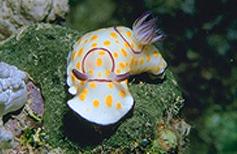
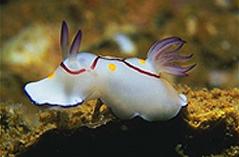
Dear Bill,
Many thanks for the identification of the Risbecia species which lead me to review some of my shots of Chromodoris annulata.
I have photographed C. annulata in the Red Sea (purple rings around rhinophores and gills). However in the Persian Gulf I found the same but with a purple line joining the two rings, a possible subspecies perhaps?
This particular specimen was about 4cm and found on a wreck at 20m depth, water temperature 33C (it gets hot here in summer).
I have included details for the Participants List
Gordon
aquashot@emirates.net.ae
Smith, G.T., 2000 (Nov 1) Chromodoris annulata from Red Sea & Persian Gulf. [Message in] Sea Slug Forum. Australian Museum, Sydney. Available from http://www.seaslugforum.net/find/3267Dear Gordon,
Thanks for completing the yellow-spotted story. I've seen a photo of that interesting form with a purple connecting line between the rings. I'm not sure where it was from but I will have a look for it when I return in december from the Loyalty Islands. Your mention of 33 degree water temperatures brings back bad memories of 2 months I spent in 1971 at Okha on the Gulf of Kutch (NW India) on the eastern side of the Arabian Sea. I couldn't understand how anything survived in the water let alone out of the water.
Best wishes,
Bill Rudman.
Can nudibranchs breath air?
September 2, 2000
From: Valda Fraser
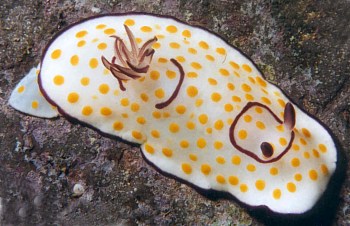
Dear Bill
Chromodoris annulata occurs along the coast of KwaZulu-Natal as well as in the colder waters off the Transkei. I was surprised to find a specimen stranded on some sand between scattered rocks at low tide. Please tell me how it, and a nearby Chromodoris conchyliata could live breathing air?
Locality: Transkei, SOUTH AFRICA - intertidal zone
Size: 45mm
Date: July 2000
Regards
Valda Fraser
valdafraser@mweb.co.za
Fraser, V., 2000 (Sep 2) Can nudibranchs breath air?. [Message in] Sea Slug Forum. Australian Museum, Sydney. Available from http://www.seaslugforum.net/find/2951Dear Valda,
Firstly, Chromodoris annulata is indeed a beautiful animal. Concerning breathing air. While terrestrial vertebrates die very quickly of immersed in water, and fish die very quickly when taken out of water, the metabolism of lowly invertebrates gives them a bit more leeway, especially when removed from water. In the case of nudibranchs with a thin skin, which is also used for gas exchange, they can remain alive for some hours as long as they remain damp. If the two chromodorids you mention were stranded in the shade, there is a chance they would survive until the tide returned, but it would certainly be a case of living dangerously.
Best wishes,
Bill Rudman.
Risbecia imperialis & Chromodoris annulata
April 11, 1999
From: Bill Rudman
Here is some information on two more yellow-spotted species of chromodorid to accompany the species of Risbecia which have just been added to the Forum. They are Risbecia imperialis and Chromodoris annulata.
Bill Rudman.
